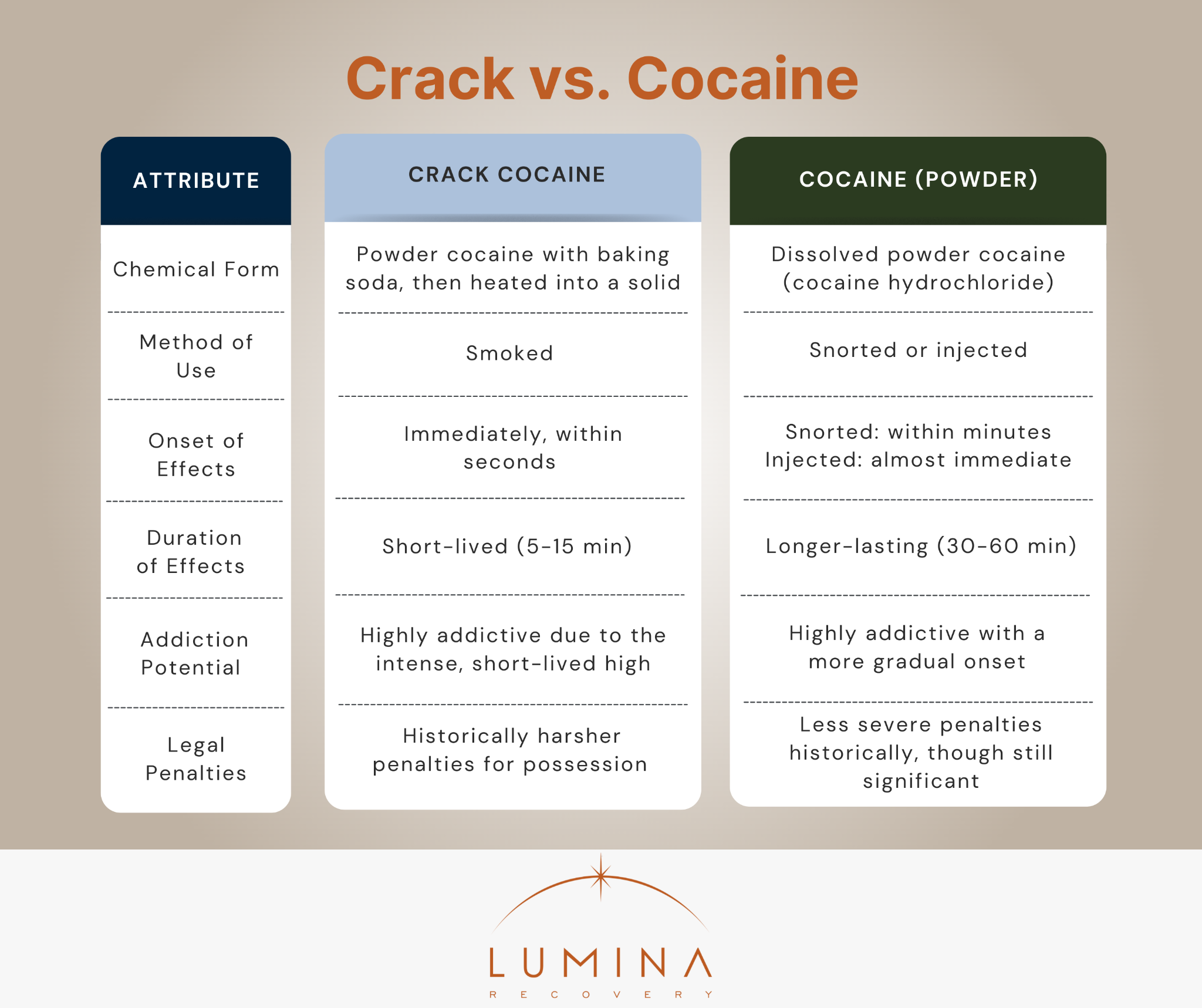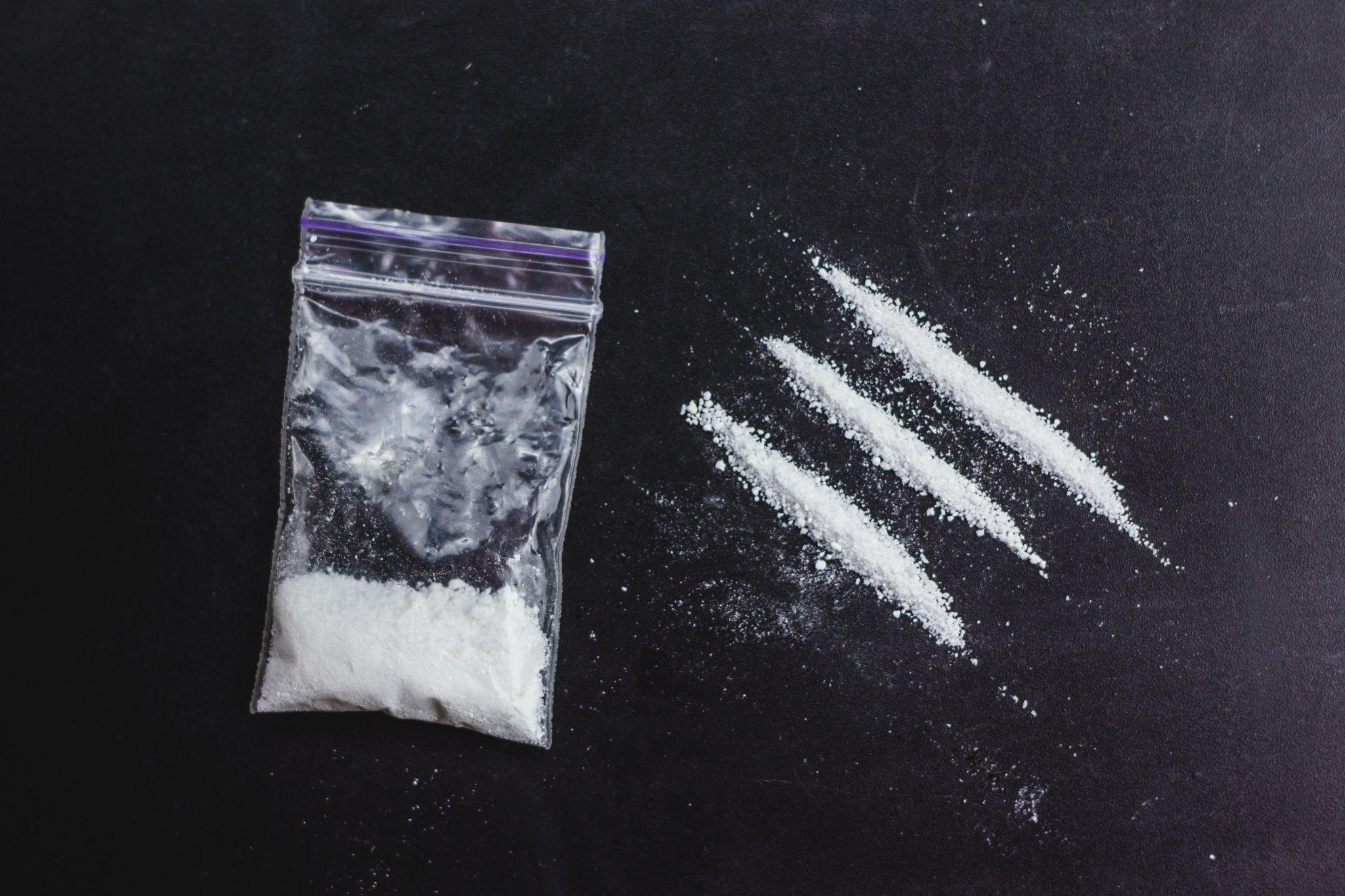Cocaine and crack cocaine are two highly addictive stimulants that come from the leaves of the coca plant. While both substances share similar chemical properties, their effects, methods of use, and risks vary significantly. The key differences lie in how they are processed, consumed, and how quickly they impact the brain and body.
Understanding the risks of cocaine and crack addiction is crucial, as both forms of the drug can have devastating effects on physical health, mental health, and overall well-being.
Key Takeaways
- Cocaine and crack cocaine differ in form and effects. Powder cocaine is usually snorted or injected, while smoking crack leads to a more intense but short-lived high.
- Both are highly addictive and pose serious health risks. Long-term use can cause increased heart rate, high blood pressure, heart attack, stroke, and mental health
- Treatment and support are essential for recovery. Detox, cognitive behavioral therapy (CBT), and support groups can help individuals stop using cocaine and rebuild their lives.

Chemical Composition and Forms
Cocaine and crack cocaine share a common origin but differ in how they are prepared and consumed.
Powder cocaine is derived directly from the leaves of the coca plant and is typically found in its hydrochloride salt form.
Crack cocaine is processed into a smokable form by mixing baking soda with powder cocaine and heating it. This alteration allows crack to be smoked, creating a more immediate and intense high than powder cocaine.
Methods of Use and Onset of Effects
The method of consumption greatly affects how cocaine and crack cocaine interact with the body.
Powder cocaine is commonly snorted or injected, producing a high that lasts longer but takes more time to take effect. In contrast, smoking crack delivers the drug rapidly into the bloodstream, leading to an almost immediate but short-lived high.
The rush from smoking crack typically lasts only a few minutes, often leading to frequent use and an increased risk of addiction. Those who inject dissolved powder cocaine experience an intense effect similar to crack but with additional risks, such as exposure to infections from needle use.
Pharmacological Effects
Both forms of cocaine affect the brain by increasing dopamine levels, leading to a powerful but temporary feeling of pleasure. This dopamine surge is responsible for the euphoria, increased energy, and heightened alertness that users experience.1
However, these effects come at a cost, as repeated use quickly depletes dopamine levels, leading to cravings, depression, and withdrawal symptoms once the drug wears off.1
Short-Term Effects of Cocaine and Crack
- Boosted energy and confidence
- Dilated pupils
- Elevated body temperature and blood pressure
Long-Term Effects of Cocaine and Crack
- Tolerance and cocaine toxicity
- Increased risk of panic attacks and paranoia
- Severe mental health decline
Health Risks and Dangers
Both cocaine and crack cocaine can cause severe and lasting health issues. Repeated use puts immense strain on the body, particularly the cardiovascular and neurological systems.1
Cardiovascular Risks
- Increased heart rate and high blood pressure
- Heart attack and stroke risk from prolonged use
Neurological Risks
- Seizures and movement disorders
- Long-term cognitive decline
Respiratory Problems
- Chronic cough and lung damage
- Respiratory infections and difficulty breathing
Mental Health and Behavioral Risks
- Anxiety, paranoia, aggression
- Psychosis and hallucinations

Addiction Potential and Withdrawal
Both forms of cocaine are highly addictive, but crack cocaine is often considered more addictive due to its rapid and intense effects. Because the high from smoking crack is so short-lived, users frequently consume more, quickly leading to dependence.
Withdrawal Symptoms
- Depression and anxiety
- Fatigue and intense cravings
- Disturbing dreams and irritability
The short-lived euphoria of smoking crack encourages users to consume more, making it difficult to stop using cocaine without professional treatment.
Legal Implications and Sentencing Disparities
The legal consequences of cocaine and crack cocaine possession have historically been vastly different. Penalties for crack cocaine have been far harsher than those for powder cocaine, contributing to significant racial and socioeconomic disparities in incarceration rates.
Historically, possessing 5 grams of crack cocaine led to the same prison sentence as possessing 500 grams of powder cocaine (100:1 ratio). The Fair Sentencing Act of 2010 reduced this disparity to 18:1, but racial and economic inequalities persist.2
Social and Economic Impact
Cocaine and crack cocaine not only affect individuals but also have broader consequences on families, communities, and society. Addiction can lead to financial struggles, broken relationships, and a decline in community stability.
On Individuals
- Job loss and financial strain
- Struggles with family and relationships
- Declining physical and mental health
On Communities
- Rising crime rates in areas with high drug use
- Economic instability due to reduced workforce participation
- Strain on healthcare systems
Treatment Options and Recovery
Overcoming cocaine and crack addiction requires a comprehensive treatment plan that addresses both the physical and psychological aspects of addiction. The first step is medical detox, where healthcare professionals monitor withdrawal symptoms and provide necessary support to ensure safety and comfort.
Detox alone is not enough, as long-term recovery depends on behavioral therapies like cognitive behavioral therapy (CBT), which helps individuals identify triggers, develop coping strategies, and change harmful thought patterns.
Both inpatient and outpatient rehabilitation programs offer structured environments for recovery, with group and individual therapy sessions to support long-term sobriety. Family therapy can help rebuild relationships and create a supportive network for sustained recovery. Seeking help early increases the chances of lasting success.
FAQs
What is the difference between crack and cocaine?
Cocaine is a powdered form of the drug, often snorted or injected. Crack is a freebase form of cocaine that is processed into small rocks, which are typically smoked for a faster, more intense, but shorter high.
Which is more addictive: crack or powder cocaine?
Crack is generally considered more addictive due to its fast-acting nature and brief high, leading users to take more frequent doses.
How does the method of use affect the intensity of cocaine’s effects?
Smoking crack leads to an almost immediate and intense high, while snorting or injecting powdered cocaine results in a longer-lasting but less intense experience.
What are the long-term health risks associated with crack cocaine use?
Chronic crack use can lead to lung damage, cognitive impairment, cardiovascular disease, and severe psychological effects such as paranoia and aggression.
Are the legal penalties different for crack and powder cocaine?
Yes. Penalties for crack cocaine have historically been harsher, though reforms have narrowed the sentencing gap.2
Get Help for Crack and Cocaine Addiction With Lumina Recovery
Understanding the differences between cocaine vs. crack is essential for recognizing their unique risks, addiction potential, and the importance of seeking proper treatment. While crack leads to a faster, more intense high, both substances can be life-threatening.
At Lumina Recovery, we provide comprehensive crack and cocaine treatment programs, including detox services to help individuals stop using cocaine and cognitive behavioral therapy (CBT) to address addiction at its core.
If you or a loved one is struggling with cocaine and crack addiction, reach out to Lumina Recovery today and take the first step toward healing.
Sources:
- National Institute on Drug Abuse. Cocaine.
- Palamar JJ, Davies S, Ompad DC, et al. Powder cocaine and crack use in the United States: an examination of risk for arrest and socioeconomic disparities in use. Drug Alcohol Depend. 2015 Apr 1;149:108-16. doi: 10.1016/j.drugalcdep.2015.01.029.


